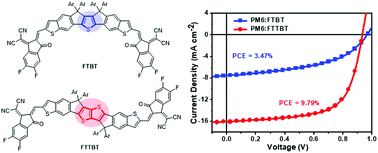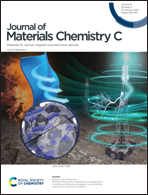Boosted photovoltaic performance of indenothiophene-based molecular acceptor via fusing a thiophene†
Abstract
Two indenothiophene-based non-fullerene small molecule acceptors (NFSMAs), FTBT and FTTBT, were designed and synthesized to investigate the photovoltaic effect of fusing a thiophene into the core of NFSMAs. Compared with the none-fused FTBT, the thiophene-fused FTTBT achieves a much higher power conversion efficiency (PCE) of 9.79% with a Voc of 0.934 V, a Jsc of 16.01 mA cm−2 and an FF of 65.49%, when it was blended with PM6 polymer donor to fabricate bulk-heterojunction solar cells. Combined photophysical, electrochemical, photovoltaic property and morphology analysis indicates that the boosted device performance mainly lies in two reasons: (i) the incorporation of an electron-donating thiophene ring narrows the optical bandgap by extending π-conjugation, which contributes to a large short-circuit current; (ii) the incorporation of a single thiophene ring transforms the axisymmetrical molecular configuration into a centrosymmetrical one, which decreases the crystallinity and optimizes the packing feature in the blend. It results in a transport-favorable blending morphology and contributes to a high fill factor. The work clarifies an effective molecular design strategy for performance enhancement of organic solar cells.



 Please wait while we load your content...
Please wait while we load your content...